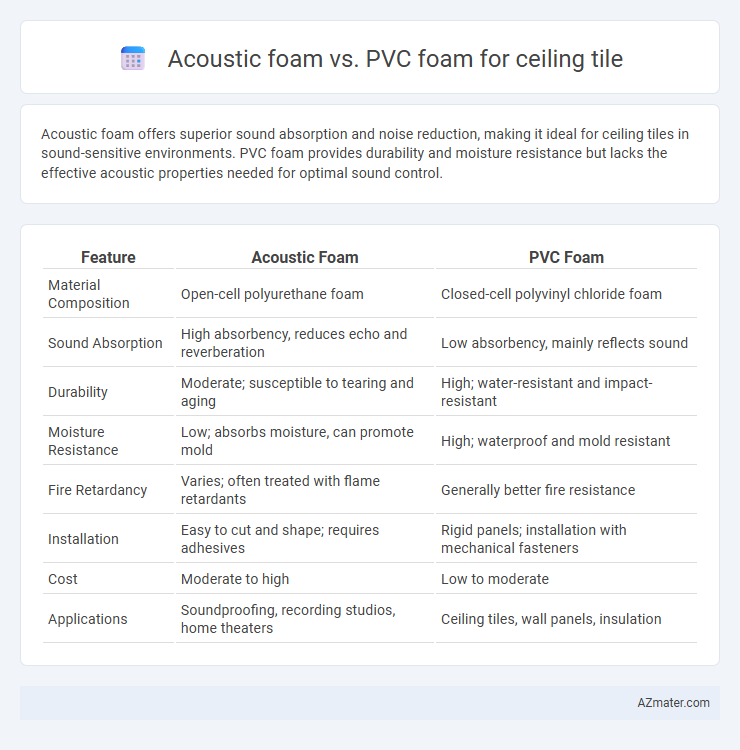Acoustic foam offers superior sound absorption and noise reduction, making it ideal for ceiling tiles in sound-sensitive environments. PVC foam provides durability and moisture resistance but lacks the effective acoustic properties needed for optimal sound control.
Table of Comparison
| Feature | Acoustic Foam | PVC Foam |
|---|---|---|
| Material Composition | Open-cell polyurethane foam | Closed-cell polyvinyl chloride foam |
| Sound Absorption | High absorbency, reduces echo and reverberation | Low absorbency, mainly reflects sound |
| Durability | Moderate; susceptible to tearing and aging | High; water-resistant and impact-resistant |
| Moisture Resistance | Low; absorbs moisture, can promote mold | High; waterproof and mold resistant |
| Fire Retardancy | Varies; often treated with flame retardants | Generally better fire resistance |
| Installation | Easy to cut and shape; requires adhesives | Rigid panels; installation with mechanical fasteners |
| Cost | Moderate to high | Low to moderate |
| Applications | Soundproofing, recording studios, home theaters | Ceiling tiles, wall panels, insulation |
Introduction to Ceiling Tile Materials
Ceiling tiles made from acoustic foam provide superior sound absorption, reducing echo and noise levels in spaces like offices and studios. PVC foam ceiling tiles offer durability, moisture resistance, and easy maintenance, making them ideal for humid environments such as bathrooms and kitchens. Selection depends on the primary functional requirement: acoustic performance favors acoustic foam, while resilience and moisture resistance point to PVC foam.
What is Acoustic Foam?
Acoustic foam is a sound-absorbing material designed to reduce noise, echo, and reverberation in indoor spaces by trapping sound waves. It is typically made from polyurethane or melamine and features a porous, open-cell structure that enhances acoustic performance. Unlike PVC foam, which primarily provides insulation and structural support, acoustic foam is engineered specifically for improving sound quality in rooms such as studios, theaters, and offices.
What is PVC Foam?
PVC foam is a lightweight, rigid material made from polyvinyl chloride that offers excellent durability and moisture resistance, making it ideal for ceiling tile applications in humid environments. Unlike acoustic foam, which primarily focuses on sound absorption, PVC foam provides structural support and easy maintenance while offering moderate soundproofing capabilities. Its closed-cell structure ensures long-lasting performance without warping or deterioration, distinguishing it as a versatile choice for ceiling installations.
Sound Absorption Capabilities: Acoustic vs PVC Foam
Acoustic foam ceiling tiles excel in sound absorption due to their open-cell structure, which effectively traps and dissipates sound waves, reducing echo and noise levels in a room. PVC foam tiles have a closed-cell composition that provides minimal sound absorption, making them less effective for acoustic treatment but more durable and moisture-resistant. For environments prioritizing sound control, acoustic foam offers superior sound absorption performance compared to PVC foam ceiling tiles.
Thermal Insulation Comparison
Acoustic foam offers superior thermal insulation due to its open-cell structure, which effectively traps air and reduces heat transfer in ceiling tile applications. PVC foam, while providing some insulation properties, has a denser, closed-cell composition that results in lower thermal resistance compared to acoustic foam. When prioritizing thermal insulation for ceiling tiles, acoustic foam ensures better energy efficiency and temperature regulation.
Fire Resistance and Safety Ratings
Acoustic foam typically offers superior fire resistance compared to PVC foam, often meeting ASTM E84 Class A fire safety ratings essential for ceiling tiles in commercial buildings. PVC foam ceiling tiles tend to have lower fire resistance and may release toxic fumes when exposed to high heat, posing safety risks. Selecting acoustic foam enhances compliance with fire codes and improves occupant safety in fire-prone environments.
Durability and Lifespan
Acoustic foam ceiling tiles offer moderate durability with a typical lifespan of 5 to 10 years, but they are more susceptible to damage from moisture and UV exposure. PVC foam ceiling tiles provide superior durability, being water-resistant, mold-resistant, and capable of lasting 15 to 25 years under similar conditions. For long-term applications requiring moisture resistance and minimal maintenance, PVC foam is generally the more durable and long-lasting option compared to acoustic foam.
Installation Process and Maintenance
Acoustic foam ceiling tiles offer simple installation with lightweight, adhesive-friendly panels that can be easily cut to fit irregular spaces, reducing labor time and complexity. PVC foam ceiling tiles require more precise handling due to their rigidity and often need mechanical fasteners or clips for secure mounting, leading to a slightly longer installation process. Maintenance of acoustic foam involves periodic dusting and replacement every few years due to material degradation, whereas PVC foam tiles are water-resistant, easy to clean with mild detergents, and exhibit greater long-term durability in humid environments.
Cost Analysis: Acoustic Foam vs PVC Foam
Acoustic foam typically costs more per square foot than PVC foam due to its specialized sound-absorbing properties, with prices ranging from $1.50 to $3.50 compared to PVC foam's $0.80 to $2.00. While acoustic foam offers superior noise reduction, PVC foam provides a budget-friendly option with moderate sound insulation and greater durability against moisture and impact. Long-term costs may favor PVC foam in environments prone to humidity, reducing replacement frequency despite its lower initial price.
Best Applications and Use Cases
Acoustic foam excels in sound absorption, making it ideal for recording studios, home theaters, and noisy office spaces where reducing echo and improving audio clarity is crucial. PVC foam offers superior durability and moisture resistance, making it better suited for ceiling tiles in high-humidity environments like kitchens, bathrooms, and industrial settings. Choosing between acoustic foam and PVC foam depends on whether sound control or environmental resilience is the primary concern for the ceiling application.

Infographic: Acoustic foam vs PVC foam for Ceiling tile
 azmater.com
azmater.com